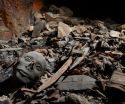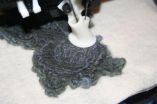(Press-News.org) Scientists studying brain diseases may need to look beyond nerve cells and start paying attention to the star-shaped cells known as "astrocytes," because they play specialized roles in the development and maintenance of nerve circuits and may contribute to a wide range of disorders, according to a new study by UC San Francisco researchers.
In a study published online April 28, 2014 in Nature, the researchers report that malfunctioning astrocytes might contribute to neurodegenerative disorders such as Lou Gehrig's disease (ALS), and perhaps even to developmental disorders such as autism and schizophrenia.
David Rowitch, MD, PhD, UCSF professor of pediatrics and neurosurgery and a Howard Hughes Medical Institute investigator, led the research.
The researchers discovered in mice that a particular form of astrocyte within the spinal cord secretes a protein needed for survival of the nerve circuitry that controls reflexive movements. This discovery is the first demonstration that different types of astrocytes exist to support development and survival of distinct nerve circuits at specific locations within the central nervous system.
Astrocytes vastly outnumber signal-conducting neurons, and make up the majority of cells in the brain. But where neuroscientists are accustomed to seeing only vanilla when it comes to astrocytes – viewing all of them as similar despite their different locations in brain and spinal cord -- they now will have to imagine "31 flavors" or more.
There might even be hundreds of distinctive varieties of astrocytes performing specific functions in different locations, according to Rowitch, chief of neonatology for UCSF Benioff Children's Hospital San Francisco.
"Our study shows roles for specialized astrocytes that function to support particular kinds of neurons in their neighborhood," Rowitch said.
Led by Rowitch lab postdoctoral fellow Anna Molofsky, MD, PhD, the researchers studied the spinal cord sensory motor circuit, which allows both mice and humans to react without thought – to jerk a limb away from something hot, for instance.
The team discovered that a protein called Sema3a is produced much more abundantly by astrocytes close to motor neurons than by astrocytes from other regions in the spinal cord. They concluded that motor neurons required this source of Sema3a from the local astrocytes, because when Sema3a production was blocked, the motor neurons failed to form normal connections, and half of them died.
Motor neurons also die in ALS, a fatal neurodegenerative disease, and in spinal muscular atrophy, a disease that can affect newborn infants. In other studies, scientists have found that abnormal astrocytes can have toxic effects on motor neurons.
Molofsky is a psychiatrist who studies how astrocytes organize nerve circuits, and how disruptions of these nerve circuits during development or disease may involve abnormal astrocyte function. Disrupted neural circuits are believed to be responsible for certain psychiatric disorders.
"The immediate implications of this study are for diseases of motor neurons, like ALS, but I think our findings might also apply more generally to diseases of neural-circuit formation in the brain such as autism, schizophrenia and epilepsy," Molofsky said. "To achieve a comprehensive understanding of how neural circuits form and are maintained, it seems important that we integrate knowledge of how astrocytes support that process."
Rowitch agrees. "To the extent that psychiatric or neurological disease is localized to a specific part of the brain, we should now be considering the potentially specialized type of astrocytes regulating nerve connections in that region and their contributions to disease," he said.
INFORMATION:
The research was funded by the National Institute for Neurological Diseases and Stroke, the National Institute of Mental Health and the Howard Hughes Medical Institute.
UCSF is a leading university dedicated to promoting health worldwide through advanced biomedical research, graduate-level education in the life sciences and health professions, and excellence in patient care. It includes top-ranked graduate schools of dentistry, medicine, nursing and pharmacy, a graduate division with nationally renowned programs in basic biomedical, translational and population sciences, as well as a preeminent biomedical research enterprise and two top-ranked hospitals, UCSF Medical Center and UCSF Benioff Children's Hospital San Francisco.
Overlooked cells hold keys to brain organization and disease, UCSF study shows
2014-04-28
ELSE PRESS RELEASES FROM THIS DATE:
Loss of Y chromosome can explain shorter life expectancy and higher cancer risk for men
2014-04-28
It is generally well known that men have an overall shorter life expectancy compared to women. A recent study, led by Uppsala University researchers, shows a correlation between a loss of the Y chromosome in blood cells and both a shorter life span and higher mortality from cancer in other organs.
Men have a shorter average life span than women and both the incidence and mortality in cancer is higher in men than in women. However, the mechanisms and possible risk factors behind this sex-disparity are largely unknown. Alterations in DNA of normal cells accumulate throughout ...
Extremes in wet, dry spells increasing for South Asian monsoons, Stanford scholars say
2014-04-28
Stanford scientists have identified significant changes in the patterns of extreme wet and dry events that are increasing the risk of drought and flood in central India, one of the most densely populated regions on Earth.
The discoveries, detailed in the April 28 issue of the journal Nature Climate Change, are the result of a new collaboration between climate scientists and statisticians that focused on utilizing statistical methods for analyzing rare geophysical events. These new approaches reveal that the intensity of extremely wet spells and the number of extremely ...
Indiana University researchers gauge the toll of trampoline fractures on children
2014-04-28
INDIANAPOLIS -- Trampoline accidents sent an estimated 288,876 people, most of them children, to hospital emergency departments with broken bones from 2002 to 2011, at a cost of more than $400 million, according to an analysis by researchers at the Indiana University School of Medicine.
Including all injuries, not just fractures, hospital emergency rooms received more than 1 million visits from people injured in trampoline accidents during those 10 years, boosting the emergency room bills to just over $1 billion, according to the study.
The research, published online ...
Urbanization, higher temperatures can influence butterfly emergence patterns
2014-04-28
An international team of researchers has found that a subset of common butterfly species are emerging later than usual in urban areas located in warmer regions, raising questions about how the insects respond to significant increases in temperature.
"We know that butterflies emerge earlier in North Carolina than they do in New England, because it's warmer," says Tyson Wepprich, a Ph.D. student at NC State and co-author of a paper describing the work. "We also know that cities are heat sinks that are warmer than outlying areas. So we wanted to see whether butterflies would ...
Basel Egyptologists identify tomb of royal children
2014-04-28
Who had the privilege to spend eternal life next to the pharaoh? Close to the royal tombs in the Egyptian Valley of the Kings, excavations by Egyptologists from the University of Basel have identified the burial place of several children as well as other family members of two pharaohs.
Basel Egyptologists of the University of Basel Kings' Valley Project have been working on tomb KV 40 in the Valley of the Kings close to the city of Luxor for three years. From the outside, only a depression in the ground indicated the presence of a subterranean tomb. Up to now, nothing ...
Criminal behavior: Older siblings strongly sway younger siblings close in age
2014-04-28
If a sibling commits a violent criminal act, the risk that a younger sibling may follow in their footsteps is more likely than the transmission of that behavior to an older sibling, according to a new study conducted by researchers at Virginia Commonwealth University and Lund University in Sweden.
The findings provide insight into the social transmission of violent behaviors and suggest that environmental factors within families can be important when it comes to delinquent behavior. Down the road, the results may be used to inform strategies for prevention and treatment ...
Research shows smartphone sensors leave trackable fingerprints
2014-04-28
Research at the University of Illinois has demonstrated that smartphone sensors — not just the ones meant to track your location — can leave real-time fingerprints unique to each individual device. An attacker could use such sensor data from a given smartphone to identify it ever after, almost making the user-trackable.
Research by Electrical and Computer Engineering Associate Professor Romit Roy Choudhury and graduate students Sanorita Dey and Nirupam Roy, demonstrated that these fingerprints exist within smartphone sensors, mainly because of imperfections during the ...
Carnegie Mellon-Disney researcher invents 3D printing technique for making cuddly stuff
2014-04-28
PITTSBURGH—Soft and cuddly aren't words used to describe the plastic or metal things typically produced by today's 3D printers. But a new type of printer developed by Carnegie Mellon University and Disney Research Pittsburgh can turn wool and wool blend yarns into fabric objects that people might actually enjoy touching.
The device looks something like a cross between a 3D printer and a sewing machine and produces 3D objects made of a form of loose felt. Scott Hudson, a professor in CMU's Human-Computer Interaction Institute who developed the felting printer with Disney ...
Beyond graphene: Controlling properties of 2D materials
2014-04-28
The isolation of graphene at the University in 2004 led to the discovery of many other 2D crystals. While graphene has an unrivalled set of superlatives, these crystals cover a large range of properties: from the most conductive to isolating, from transparent to optically active.
The next step is to combine several of these crystals in a 3D stack. This way, one can create 'heterostructures' with novel functionalities – capable of delivering applications as yet beyond the imagination of scientists and commercial partners.
The first examples of such heterostructures already ...
One cell type may quash tumor vaccines
2014-04-28
(PHILADELPHIA) -- Most cancer vaccines have not lived up to their promise in clinical trials. The reason, many researchers suspect, is that the immune cells that would help the body destroy the tumor – even those reactions boosted by cancer vaccines – are actively suppressed. Now, researchers at Thomas Jefferson University have found that a single cell type is actively suppressed in several experimental cancer vaccines, paving the way toward methods to break suppression and improve the effectiveness of cancer vaccines. The work was published this week online in the European ...





